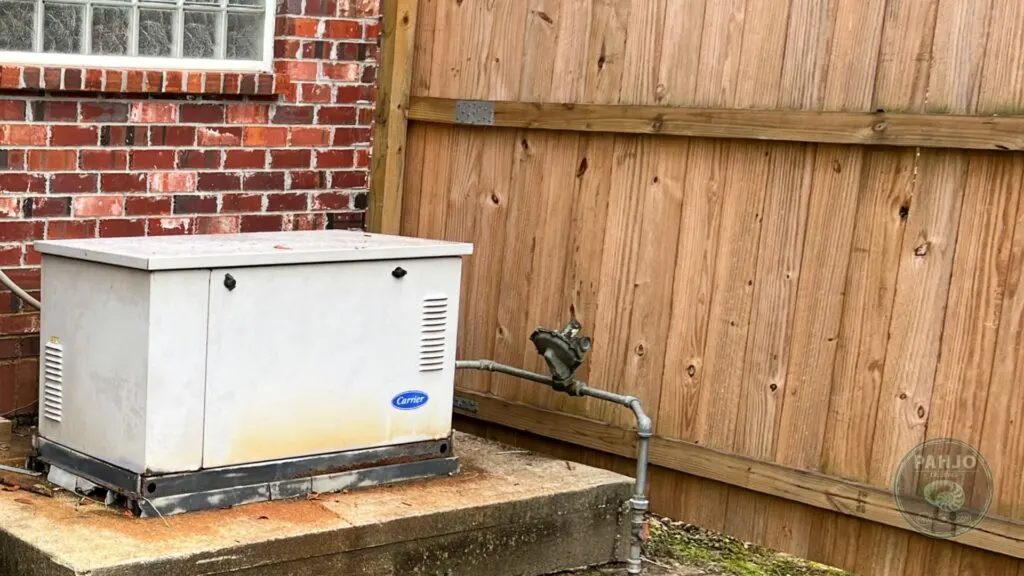In this DIY guide, I show you how to hide a whole house generator in your yard.
Even if you don’t need to hide a standby generator for unexpected power outages, the tips I cover can be used to hide an AC unit or sump pump.
Here are some jump links to the main sections of this post to help you find the information you need quickly.
Reasons to Hide Whole House Generators
Important Things to Consider
Ways Hide an Outdoor Generator (With Landscaping)
Ways Hide an Outdoor Generator (Without Landscaping)
Reasons to Hide Whole House Generators
A whole house residential generator provides a fantastic source of backup power to an entire house.
Compared to a portable generator, a whole house generator can be large and noisy.
After the backup generator installation, there are 5 main reasons to hide it.
1 – Visual Appeal

Most homeowners prioritize the look of their outdoor space and avoid outdoor eyesores.
Concealing a bulky generator in plain sight allows homeowners to match the style of their homes and landscaping.
2 – Compliance and Zoning Regulations
Local zoning regulations or HOA guidelines may require to conceal the appearance of the generator.
3 – Noise Reduction
While whole house generators are designed to operate quietly, the noise of exhaust valves can be a great distraction.
Generator owners may want to install a privacy fence to hide the generator and create a sound barrier.
4 – Preventing Vandalism or Theft
Concealing a generator helps protect it from potential vandalism or theft.
5 – Safety
Hiding a generator protects children and pets from exhaust fumes, carbon monoxide, and high temperatures.
It’s important to keep a balance between hiding a generator and maintaining proper functionality.
Factors to Consider When Hiding Home Generators
Hiding a natural gas or diesel generators while maintaining proper functionality requires planning.
More specifically, the planning should happen before the whole-house generator installation.
The generator must remain accessible and adequately ventilated to continue operation.
Ventilation
Generators require proper ventilation and clearance requirements to dissipate heat during operation.
Therefore, they should be placed on a concrete slab regardless of the fuel source.
When concealing the generator, make sure to provide sufficient airflow to prevent overheating.
If using an enclosure, design it with vents or openings to allow the free flow of air.
Access for Routine Maintenance
To maintain access for regular maintenance, removable panels or doors to allow easy access for maintenance tasks, such as refueling, oil changes, and routine inspections.
Make sure the landscaping design chosen provides a clear pathway leading to the generator for repair services. This allows a service technician to access the generator during a service call.
Outdoor Protection
Generators should be protected as much as practical from inclement weather such as rain, snow, and extreme temperatures.
While some generators are designed to withstand severe weather, the extra protection increases longevity.
How To Hide a Whole House Generator with Landscaping
The main types of generators to power an entire home come in various sizes.
Here are some of the most creative ways to conceal a generator that don’t require a lot of time.
Evergreen Shrubs
Evergreen Tree
Raised Flower Bed
Rock Garden
Water Feature
Evergreen Shrubs
Evergreen shrubs serve as a natural barrier and a great way to hide a whole house generator.
The dense and hardy foliage of evergreen varieties such as arborvitae, holly, or boxwood act as a continuous screen to hide the generator from view.
These fast-growing shrubs maintain their greenery throughout the year, which makes them an ideal choice.
Consider adding creeper veggies around the generator to help conceal it.
Evergreen Tree
Evergreen tree varieties such as pine, spruce, or cedar contain dense leaves that stay green all year, which hides the generator from view.
The towering height and expansive branches of these trees create a natural screen.
Flower Beds
Another good option is a raised flower bed with colorful flowers.
Choose the right plants to provide that provide good coverage and can withstand the local climate.
Also, privacy trees like arborvitae, leyland cypress, or bamboo.
These can form a natural screen to hide the generator.
Rock Garden
Decorative rocks in a rock garden or water feature creates a visual barrier around the generator.
Rocks work well in desert landscapes with a less than ideal soil type.
Most Effective Ways to Hide a Generator Without Landscaping
Hiding a new backup power system for your home without landscaping offers several benefits.
The 2 most common reasons to not using landscaping are low maintenance and to save time.
Wooden Fencing Option
Lattice Fence Panels
Custom Enclosures
Pergola Kit
Fencing

The easiest way to hide a generator is to build a wooden fence.
Make sure the fence has sufficient gaps or ventilation to allow for proper airflow and maintenance.
A lattice enclosure fence panels provide coverage while still allowing for ventilation and access.
You can grow vines or climbing plants on the lattice for additional camouflage.
Custom Enclosures
A small shed or custom enclosure around the generator is a good choice.
Keep in mind, the structure must allow for proper ventilation and access for maintenance.
Build an enclosure that complements the design of your home and yard. Consider using materials that match your house, like siding or paint.
Camouflage Cover
Purchase a generator cover and paint it to match the surroundings, such as the color of your house.
Also, earthy tones used on a generator blends it to the natural environment.
Architectural Features
A gazebo or pergola kit is the best way to protect and conceal the generator.
Additionally, architectural screens or panels attached to the gazebo hide and blend with outdoor elements.
Remember to consider local regulations, safety requirements, and access for maintenance when implementing any of these ideas.
Additionally, make sure that the chosen method allows for proper ventilation to prevent overheating of the generator.
Conclusion
I hope this article showed you how to hide a whole house generator.
Remember to keep ventilation, maintenance access for a licensed electrical worker, and compliance with local codes top of mind.
The various options I listed in this article off you a range of choices based on your unique needs and style.
With these tips in mind, you can boost your home’s curb appeal and enjoy uninterrupted power supply during a natural disaster.
Related Posts:
